Topics
Category
Era
Nonpartisan League
Exploited by powerful corporate and political interests in Minneapolis and St. Paul, Midwestern farmers banded together in the early twentieth century to fight for their political and economic rights. Farmers formed the Nonpartisan League (NPL) and wrote a significant chapter of Minnesota's progressive-era history.
In the 1910s, farmers began to decry poor market conditions and violations of their economic rights. Middlemen in the grain elevator, stockyard, cold storage, banking, and rail industries regularly gouged farmers. To fight corporate interests, the NPL was formed in North Dakota in 1915.
The NPL was founded by former Socialist Party member Arthur Townley, who was also a failed flax farmer. The NPL advocated state-run mills, grain elevators, stockyards, and warehouses. In order to protect farmers further, it fought for state insurance programs, pensions, and employment bureaus. After success in North Dakota's 1916 election, the NPL began to expand, and Minnesota became the center of its activities.
During the election cycle of 1918, Minnesota farmers tried to take control of the state's politics. On March 19, NPL delegates from across Minnesota met at the Pioneer Building in St. Paul to select candidates and develop a party platform. These farmers represented forty-eight counties that the NPL felt they could carry. The counties not represented were either urban or part of the Iron Range. The NPL agreed to back labor candidates from those counties, and the farmers were joined by supporters of the labor movement.
Former Sixth-District congressman and farmer Charles A. Lindbergh Sr. was endorsed to head the NPL ticket as its candidate for governor. Lindbergh was considered the "farmer-labor" candidate. The meeting became a rally attended by seven thousand people, but in a foreshadowing of events to come, Governor Burnquist and the mayor of St. Paul declined invitations to speak.
From the inception of its Minnesota campaign, the NPL faced strong opposition from the Minnesota Commission of Public Safety. With the United States' entry into World War I, loyalty and patriotism became political weapons. Fear of socialism and German sympathizers spread throughout the nation. To combat perceived disloyalty and sedition, the Minnesota Legislature created the Commission shortly after the start of the war.
Lindbergh opposed the United States' entry into World War I, making him and the NPL targets for accusations of disloyalty. As Governor Burnquist started his reelection campaign, backed by the Commission, he called himself the "loyalist" candidate. Burnquist and his allies successfully framed the campaign in terms of "loyalists" and the "disloyal." By doing so, they hoped to spur Democrats to cross over and vote for the governor. In addition, those opposed to the NPL used its socialist principles against it, labeling all members "Bolsheviks."
Lindbergh's campaign across Minnesota revealed a divided state. In some towns he drew very large crowds, and was welcomed as a hero. In others, however, he faced violence and strong opposition. Law enforcement, local citizens, and home guards prevented many NPL meetings. Townley and other NPL leaders were arrested. Lindbergh was stoned, hung in effigy, and shot at.
The wave of loyalism during World War I proved too much for the League, and Lindbergh lost to Burnquist in the Republican primary. After his defeat, delegates of the NPL and organized labor met separately, but they worked closely to endorse new candidates. In doing so the League deviated from its principle of endorsing candidates of existing parties. Needing a party name to place a new candidate on the general-election ballot, the NPL and labor delegates agreed on the "Farmer-Labor Party" and nominated David H. Evans. Burnquist proceeded to beat Evans, with many Democrats crossing party lines to vote for Burnquist due to his "loyalty."
The NPL declined in popularity during the 1920s, as the decade was prosperous for farmers. The formation of the Farmer-Labor party also drew the politically active. Though the NPL never gained a strong political foothold in Minnesota, the campaign of 1917–1918 remains a prominent chapter in the history of the Progressive Era. In 1925, the United States Supreme Court examined the events of the Minnesota Campaign and determined that the civil liberties of NPL members had been violated. The court ruled that states could not interfere with the Bill of Rights.
Bibliography
"Burnquist's Sand." Princeton Union, March 14, 1918.
http://chroniclingamerica.loc.gov/lccn/sn83016758/1918-03-14/ed-1/seq-1/
"Farmers are the Better Bluffers." New Ulm Review, February 27, 1918.
http://chroniclingamerica.loc.gov/lccn/sn89081128/1918-02-27/ed-1/seq-8/
Jenson, Carol. "Loyalty as a Political Weapon: The 1918 Campaign in Minnesota." Minnesota History 43, no. 2 (Summer 1972): 42–57.
http://collections.mnhs.org/MNHistoryMagazine/articles/43/v43i02p042-057.pdf
Morlan, Robert L. Political Prairie Fire: The Nonpartisan League, 1915–1922. St. Paul: Minnesota Historical Society Press, 1985.
———. "The Nonpartisan League and the Minnesota Campaign of 1918." Minnesota History 34, no. 6 (Summer 1955): 221–232.
http://collections.mnhs.org/MNHistoryMagazine/articles/34/v34i06p221-232.pdf
M182/M183
National Nonpartisan League Papers, 1915–1927 (microfilm)
Manuscript Collection, Minnesota Historical Society, St. Paul
http://www.mnhs.org/library/findaids/m0182.pdf
Description: Correspondence and miscellany with particular focus on the NPL's efforts in Minnesota.
M183
A/.T263
Henry G. Teigan Papers, undated and 1916–1941
Manuscript Collection, Minnesota Historical Society, St. Paul
Description: Correspondence and other material collected by Teigan as secretary of the National NPL.
"Nonpartisan League Head Under Arrest." Bemidji Daily Pioneer, February 28, 1918.
http://chroniclingamerica.loc.gov/lccn/sn86063381/1918-02-28/ed-1/seq-1/
"Opening Campaign Rally!!" Willmar Tribune, April 24, 1918.
http://chroniclingamerica.loc.gov/lccn/sn89081022/1918-04-24/ed-1/seq-5/
Starr, Karen. "Fighting for a Future: Farm Women of the Nonpartisan League." Minnesota History 48, no. 6 (Summer 1983): 255–262.
http://collections.mnhs.org/MNHistoryMagazine/articles/48/v48i06p255-262.pdf
Related Resources
Primary
FJK2391/.N41H8
Materials Relating to the Nonpartisan League, 1905–1920
Manuscript Collection, Minnesota Historical Society, St. Paul
Description: Materials relating to the NPL gathered by author Asher Howard.
The Nonpartisan Leader.
http://books.google.com/books?id=f0gtAQAAMAAJ&printsec=frontcover&source=gbs_ge_summary_r&cad=0#v=onepage&q&f=false
Description: National newspaper published by the NPL.
Secondary
Bloom, Howard E. "Violence Against the Non-Partisan League in Minnesota During the World War." Thesis, Funk Prize Contest, c.1930.
Bruce, Andrew A. Non-partisan League. New York: Macmillan Company, 1921.
Chrislock, Carl H. The Progressive Era in Minnesota: 1899–1918. St. Paul: Minnesota Historical Society Press, 1971.
———. Watchdog Loyalty: The Minnesota Commission of Public Safety during World War I. St. Paul: Minnesota Historical Society Press, 1991.
Lamb, Charles A. "Up from the Wheat Fields: The Nonpartisan League's Expansion into Minnesota." Master's thesis, University of Minnesota, 1978.
Lass, William E. Minnesota: A History. New York: W.W. Norton & Co., 1998.
Miller, Clark. "Unlucky Lindy: The Nonpartisan League and the Origins of the Farmer-Labor Coalition in Minnesota." [Minneapolis?]: University of Minnesota, 1978.
Russell, Charles Edward. The Story of the National Nonpartisan League: A Chapter in American Evolution. New York: Harper & Bros., 1920.
Valelly, Richard M. Radicalism in the States: The Minnesota Farmer-Labor Party and the American Political Economy. Chicago: University of Chicago, 1989.
Web
Minnesota Historical Society. History Topics: Nonpartisan League.
http://www.mnhs.org/library/tips/history_topics/102nonpartisan.html
Related Images
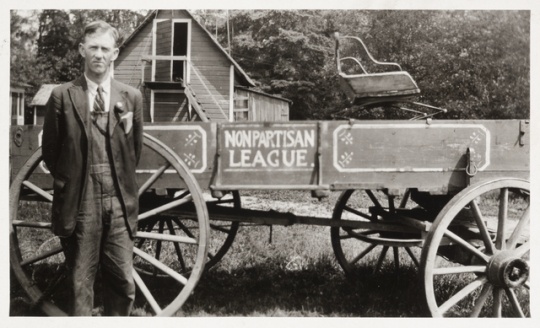
Theodore G. Mattson and his Nonpartisan League wagon box, Little Falls
Nonpartisan League member Theodore G. Mattson, c.1918.
Public domain
Holding Location
Articles
More Information

Arthur C. Townley, founder and President of the Nonpartisan League
Arthur C. Townley, founder of the Nonpartisan League, c.1915.
Public domain
Holding Location
Articles
More Information

Nonpartisan League meeting in Carver County
Nonpartisan League meeting in Carver County, 1918.
Public domain
Holding Location
More Information
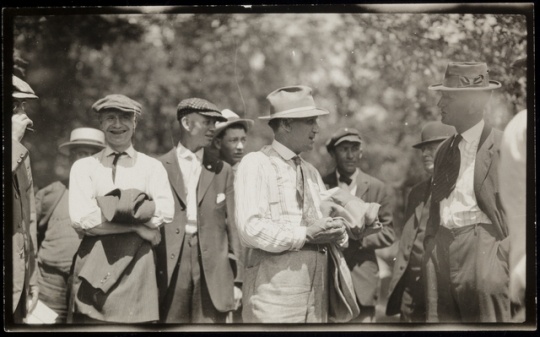
Charles A. Lindbergh, Sr., Nonpartisan League candidate, carries his message from farm to farm
Charles A. Lindbergh Sr., campaigning, c.1918.
Public domain
Holding Location
Articles
More Information
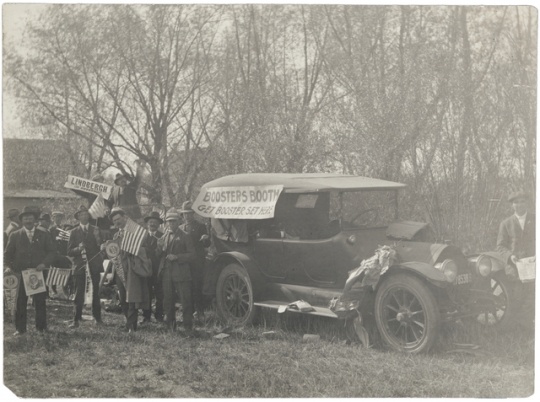
Getting their booster sets at the Nonpartisan Leagues picnic at Clarkfield
League boosters in Clarkfield, 1918.
Public domain
Holding Location
Articles
More Information
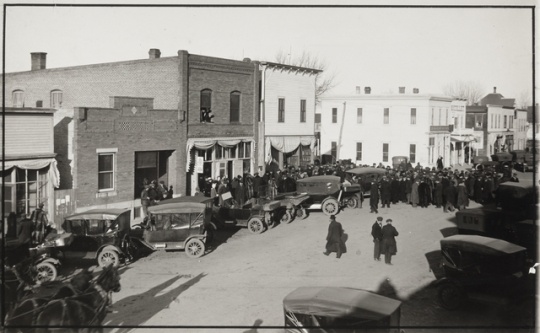
Cars and people gather for a Nonpartisan League meeting in Echo
People gather for a Nonpartisan League meeting in Echo, c.1918.
Public domain
Holding Location
Articles
More Information
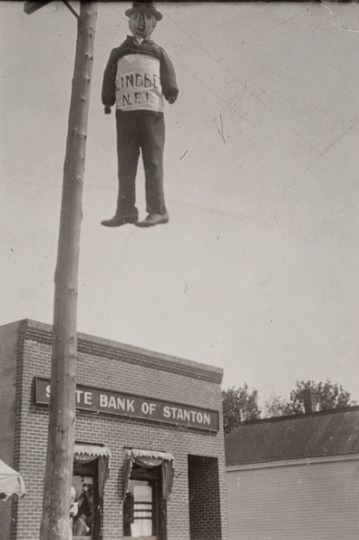
Effigy of Charles A. Lindbergh, Sr. hanging from a telephone pole in Stanton
Effigy of Charles A. Lindbergh hanging in Stanton, c.1918.
Public domain
Holding Location
More Information
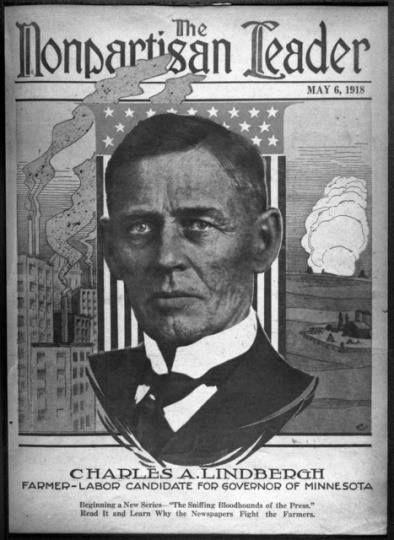
Cover of the Nonpartisan Leader featuring Charles A. Lindbergh
Charles A. Lindbergh featured on the cover of the Nonpartisan Leader, the Nonpartisan League's official publication, May 6, 1918.
Public domain
Holding Location
More Information
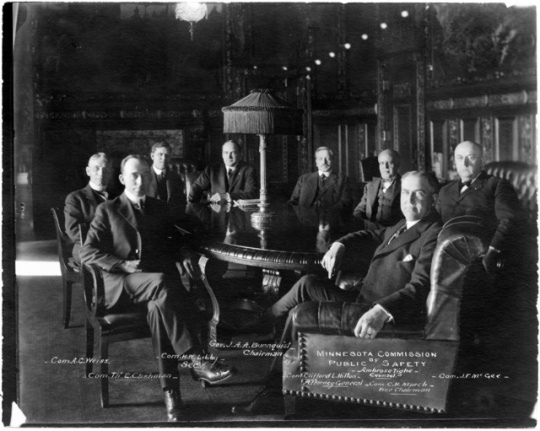
Minnesota Commission of Public Safety
Minnesota Commission of Public Safety members, c.1918.
Public domain
Holding Location
More Information
Related Articles
Turning Point
On March 19, 1918, delegates of the Minnesota Nonpartisan League meet at the Pioneer Building in St. Paul to adopt a party platform and nominate candidates for office. A two-day rally follows that inaugurates one of the most tumultuous campaigns in Minnesota history.
Chronology
1915
1917
1917–1918
Early 1918
1918
1920s
1925
Bibliography
"Burnquist's Sand." Princeton Union, March 14, 1918.
http://chroniclingamerica.loc.gov/lccn/sn83016758/1918-03-14/ed-1/seq-1/
"Farmers are the Better Bluffers." New Ulm Review, February 27, 1918.
http://chroniclingamerica.loc.gov/lccn/sn89081128/1918-02-27/ed-1/seq-8/
Jenson, Carol. "Loyalty as a Political Weapon: The 1918 Campaign in Minnesota." Minnesota History 43, no. 2 (Summer 1972): 42–57.
http://collections.mnhs.org/MNHistoryMagazine/articles/43/v43i02p042-057.pdf
Morlan, Robert L. Political Prairie Fire: The Nonpartisan League, 1915–1922. St. Paul: Minnesota Historical Society Press, 1985.
———. "The Nonpartisan League and the Minnesota Campaign of 1918." Minnesota History 34, no. 6 (Summer 1955): 221–232.
http://collections.mnhs.org/MNHistoryMagazine/articles/34/v34i06p221-232.pdf
M182/M183
National Nonpartisan League Papers, 1915–1927 (microfilm)
Manuscript Collection, Minnesota Historical Society, St. Paul
http://www.mnhs.org/library/findaids/m0182.pdf
Description: Correspondence and miscellany with particular focus on the NPL's efforts in Minnesota.
M183
A/.T263
Henry G. Teigan Papers, undated and 1916–1941
Manuscript Collection, Minnesota Historical Society, St. Paul
Description: Correspondence and other material collected by Teigan as secretary of the National NPL.
"Nonpartisan League Head Under Arrest." Bemidji Daily Pioneer, February 28, 1918.
http://chroniclingamerica.loc.gov/lccn/sn86063381/1918-02-28/ed-1/seq-1/
"Opening Campaign Rally!!" Willmar Tribune, April 24, 1918.
http://chroniclingamerica.loc.gov/lccn/sn89081022/1918-04-24/ed-1/seq-5/
Starr, Karen. "Fighting for a Future: Farm Women of the Nonpartisan League." Minnesota History 48, no. 6 (Summer 1983): 255–262.
http://collections.mnhs.org/MNHistoryMagazine/articles/48/v48i06p255-262.pdf
Related Resources
Primary
FJK2391/.N41H8
Materials Relating to the Nonpartisan League, 1905–1920
Manuscript Collection, Minnesota Historical Society, St. Paul
Description: Materials relating to the NPL gathered by author Asher Howard.
The Nonpartisan Leader.
http://books.google.com/books?id=f0gtAQAAMAAJ&printsec=frontcover&source=gbs_ge_summary_r&cad=0#v=onepage&q&f=false
Description: National newspaper published by the NPL.
Secondary
Bloom, Howard E. "Violence Against the Non-Partisan League in Minnesota During the World War." Thesis, Funk Prize Contest, c.1930.
Bruce, Andrew A. Non-partisan League. New York: Macmillan Company, 1921.
Chrislock, Carl H. The Progressive Era in Minnesota: 1899–1918. St. Paul: Minnesota Historical Society Press, 1971.
———. Watchdog Loyalty: The Minnesota Commission of Public Safety during World War I. St. Paul: Minnesota Historical Society Press, 1991.
Lamb, Charles A. "Up from the Wheat Fields: The Nonpartisan League's Expansion into Minnesota." Master's thesis, University of Minnesota, 1978.
Lass, William E. Minnesota: A History. New York: W.W. Norton & Co., 1998.
Miller, Clark. "Unlucky Lindy: The Nonpartisan League and the Origins of the Farmer-Labor Coalition in Minnesota." [Minneapolis?]: University of Minnesota, 1978.
Russell, Charles Edward. The Story of the National Nonpartisan League: A Chapter in American Evolution. New York: Harper & Bros., 1920.
Valelly, Richard M. Radicalism in the States: The Minnesota Farmer-Labor Party and the American Political Economy. Chicago: University of Chicago, 1989.
Web
Minnesota Historical Society. History Topics: Nonpartisan League.
http://www.mnhs.org/library/tips/history_topics/102nonpartisan.html










